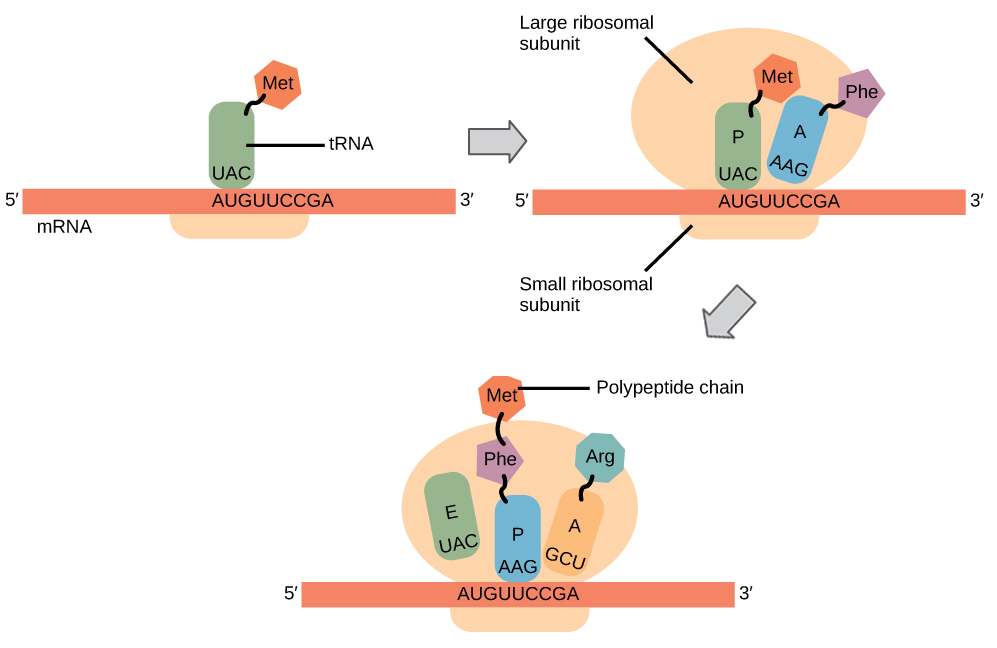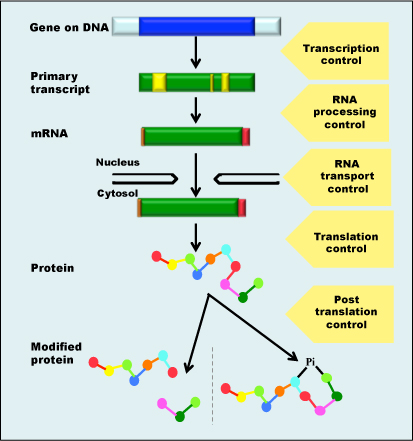Translation Study Guide
Introduction
If we try to understand the literal meaning of ‘translation,’ it would simply mean “to carry across.” In the case of gene expressions, what is being translated is the information originally included in DNA and was already present in the genome. Then it gets transcribed into messenger RNA, and later that information is translated from the messenger RNA to a protein.
Translation overview
The process of translation occurs outside the nucleus. In translation, the messenger RNA formed in transcription is sent out of the nucleus. It goes into the cytoplasm and then to the ribosome. Then this messenger RNA directs the protein synthesis. Messenger RNA is not directly involved in protein synthesis and requires a transfer RNA (tRNA). Hence, this process in which a messenger RNA directs the protein synthesis with the help of transfer RNA is known as translation.
Steps of translation
There are three key steps of translation. Each of these steps is associated with different proteins. At every step, ATP and GTP are used as energy sources.
- Initiation- In the initiation stage, mRNA, tRNA, and an amino acid meet up inside the ribosome. The first transfer RNA (tRNA) is attached at the start codon. This setup is known as initiation complex and is needed to get the translation started. Once the translation is initiated, it continues down the line as mRNA shifts along through the ribosome.
- Elongation- In the elongation stage, the amino acid chain gets longer. In this process, the mRNA reads one codon at a time, and the amino acid matching each codon is added to the growing protein chain. The ribosome continues to translate each codon, one after the other. Each corresponding amino acid is added to the growing chain and linked with a peptide bond. Elongation continues until all of the codons are read.
- Termination- In the termination stage, the finished polypeptide chain is released. It begins when a stop codon enters the ribosome, triggering a series of events that separate the chain from its tRNA and allow it to drift out of the ribosome.
Purpose of translation
The translation is the synthesis of a protein from an mRNA template. The purpose of translation is to synthesize proteins used for millions of cellular functions.
Salient features of translation
The salient features of translation are:
- The translation is initiated when the rRNA in the ribosome interacts with the mRNA at the start codon.
- The sequence of nucleotides on the mRNA is read in triplets called codons.
- Each codon encodes a specific amino acid, which can be deduced using a genetic code chart. Many amino acids are encoded by more than one codon.
- Nearly all living organisms use the same genetic code, which is evidence for the common ancestry of all living organisms.
- tRNA brings the correct amino acid to the correct place specified by the codon on the mRNA.
- The amino acid is transferred to the growing polypeptide chain.
- The process continues along the mRNA until a stop codon is reached.
- The process terminates by the release of the newly synthesized polypeptide/protein.
Difference between transcription and translation
The process of transcription and translation are together termed gene expression.
- In the transcription process, the DNA sequence of a gene is rewritten in the form of RNA. In eukaryotes, the RNA is processed to make the final product, known as the messenger RNA (mRNA).
- Whereas in the process of translation, the mRNA is decoded to build a protein that contains a specific series of amino acids.
Regulation of gene expression
Regulation of gene expression is described as a process of turning genes on and off. It involves a wide range of mechanisms used by cells to increase or decrease the production of specific RNA or protein. During early development, cells begin to take on specific functions. Gene regulation ensures that the appropriate genes are expressed at the proper times.
Gene regulation is essential for viruses, eukaryotes, and also prokaryotes as it increases the versatility and adaptability of the organisms by allowing the cell to express protein when needed.
Gene expression is regulated on two levels.
- Transcription regulation- Transcription is controlled by limiting the amount of mRNA produced from a particular gene.
- Translational regulation- Translation of mRNA into proteins is regulated through post-transcriptional events. Translational regulation means control of the levels of protein synthesized from its mRNA. It results in much more immediate cellular adjustment through direct regulation of protein concentration than transcriptional regulation.
Translational Control
Translational control is used to regulate gene expression. Translational control governs the efficiency of mRNAs and thus plays an important role in modulating the expression of many genes that respond to signals such as nutrient supply, hormones, or stress.
Conclusion
- The translation is how messenger RNA is used to direct protein synthesis.
- In molecular biology and genetics, the entire process of translation and transcription is referred to as gene expression.
- Translation occurs outside the nucleus.
FAQs:
1. How is gene expression regulated in translation?
Gene expression is regulated on two levels. First, transcription is controlled by limiting the amount of mRNA produced from a particular gene. In the second level, mRNA translation into proteins is regulated through post-transcriptional events.
2. Can gene expression be regulated during translation?
Gene expression is regulated at multiple levels, including the translation of mRNAs into proteins.
3. What is the relationship between translation and gene expression?
The translation is the second major step in gene expression. The mRNA is “read” in translation according to the genetic code, which relates the DNA sequence to the amino acid sequence in proteins.
4. Does gene expression include translation?
Yes, gene expression includes translation. It is the second step after transcription.
5. What is the difference between gene expression and gene regulation?
The key difference between gene expression and gene regulation is that gene expression is the process that synthesizes a protein by using the information in a gene. In contrast, gene regulation is the process of controlling the rate and the manner of gene expression.
6. Can gene expression be regulated before transcription?
Yes, gene expression can be regulated before transcription. Eukaryotic gene expression begins with control of access to the DNA. This regulation is known as epigenetic regulation, and it occurs even before transcription is initiated.
We hope you enjoyed studying this lesson and learned something cool about Translation! Join our Discord community to get any questions you may have answered and to engage with other students just like you! Don’t forget to download our App to experience our fun, VR classrooms – we promise, it makes studying much more fun! 😎
Sources:
- Translation. https://biologydictionary.net/translation/. Accessed 20 Dec, 2021.
- Translation. https://atdbio.com/nucleic-acids-book/Transcription-Translation-and-Replication. Accessed 20 Dec, 2021.
- Translation. https://flexbooks.ck12.org/cbook/ck-12-biology-flexbook-2.0/section/4.7/primary/lesson/translation-of-rna-to-protein-bio/. Accessed 20 Dec, 2021.


